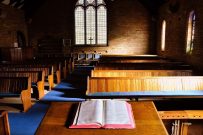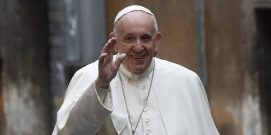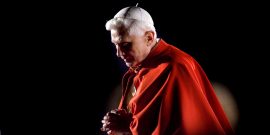Even ardent secularists should recognize the benefits that flow from religion appearing in the public sphere.
What Catholics Saw in America
Christian nationalism has a particularly bad odor these days (think January 6). But it is still the standard operating procedure for the study of Christian history. To the extent that historians tell the stories of particular communions (what Protestants called denominational history), they do so with the tools of the nation-state. Historians of Protestantism in the United States rarely if ever consider Canadian Protestantism, a major exception being Mark A. Noll’s A History of Christianity in the United States and Canada. The idea of including Mexican churches in a study of American Christianity is almost as unthinkable as Donald Trump becoming president once was. Even after the turn from denominational to religious history, academics rarely follow their subjects through customs.
As odd as the privileged position of nation-states may be for the study of Protestantism, it makes even less sense for Roman Catholicism since part of the point of being Catholic is to be in a communion that transcends national identities and polities. National churches have, in fact, always been a drag on Rome’s catholicity. The English church is arguably the most notable example and qualifies as the first state-sponsored communion to demonstrate that ecclesiastical nationalism leads to independence. But even before Henry VIII took the unusual step of declaring ecclesiastical autonomy, French monarchs asserted vigorously their own prerogatives in appointing bishops. Gallicanism meant the French king’s right to control the temporal aspects of the church in his domain. That disputed position was partly responsible for the removal of the papacy to Avignon (1309-1376) and the Western Schism from 1378 to 1417.
The American Church made its own contribution to such ecclesiastical nationalism in the form of Americanism. This outlook developed in the last third of the nineteenth century and its advocates held that Roman Catholicism needed to accommodate aspects of America’s liberal and democratic order. Americanism received a mild papal condemnation in 1899 from Leo XIII, which reflected a long-held suspicion among Vatican officials that politically oriented expressions of faith invariably evaded Rome’s norms. Not until the Second Vatican Council did the hierarchy give a green light to the formation of such bodies as the United States Conference of Catholic Bishops. What applied to American bishops also held for other national conferences, namely, that these assemblies could rule with “juridically binding force.”
This is a long-winded way of introducing Leslie Woodcock-Tentler’s new history of Roman Catholics in the United States, but reminders of this sort are relevant because historians of the American church need to reckon with Americanism. The old version of Americanism may have gone into hiding after Leo XIII’s encyclical, but a modern version, often called neo-Americanism by critics, flourished in the United States during much of the Cold War. Writers and editors, including Richard John Neuhaus and George Weigel through magazines such as First Things, blended American exceptionalism and Roman Catholic conservatism in ways that became mainstream in the American church. Roman Catholics on the progressive side of the church and national politics, along with integralists on the Right, have generally faulted neo-Americanists for being too American.
In American Catholics, Tentler is largely indifferent to these debates. Nor does she allow American politics, even the presidency, to frame her narrative. She makes passing references, for instance, to LBJ and Ronald Reagan, while noting American Catholics’ support for FDR. John F. Kennedy, “at best a lukewarm Catholic,” was a vindication of Roman Catholics’ “membership in the national polity.” Tentler, who likely completed the manuscript before the 2020 presidential primaries, does not mention Joe Biden. Her concern is to tell the history of the church with the nation merely functioning as the stage for church actors.
Tentler also refused to dip in the sometimes-turbulent waters where national political ideals (democracy and liberty) create waves for church teaching the way John McGreevy’s Catholicism and American Freedom (2003) carefully distinguished between American and church understandings of liberty. Tentler may not be as overtly friendly to egalitarianism and democracy as Jay Dolan was In Search of An American Catholicism (2003). But she clearly sides with the laity and especially the distaff side of the church. These sympathies reflect her previous work, such as Wage-Earning Women: Industrial Employment and Family Life in the United States, 1900-1930 (1979). The index to American Catholics, arguably not the best way to read a book, is nevertheless a useful guide to Tentler’s interests. The following entries stand out: “annulments,” “assimilation,” “gender,” “German Catholics,” “Hispanic Catholics in the United States,” “immigration,” Irish Catholics in the United States,” “Italian Catholics in the United States,” “Polish Catholics,” “schools, Catholic,” and “women religious.”
Tentler does not ignore the bishops or clergy. At least fifty bishops appear in the index and “clergy” take up almost an entire column. Related to the presence of bishops are fascinating treatments of large urban dioceses. Chicago, Boston, New York, and Philadelphia receive their appropriate attention, but Detroit stands out for special recognition, a place Tentler knows well, having taught for many years at the University of Michigan-Dearborn and written a book on the history of the Detroit diocese. To her credit, Tentler is also attentive to Roman Catholic piety, with “confession,” “Eucharistic devotions,” “liturgy, Catholic,” and “Marian devotion” taking up substantial space. Tentler also draws on her previous study of debates over contraception in Catholics and Contraception: An American History (2004). With these subjects come more attention to women and reproduction than many historians of American Catholics usually give.
Tentler judges the American church to have been largely successful in adapting to a modern, democratic, and affluent society until the period after the Second Vatican Council.
Despite her friendliness to the laity, Tentler avoids predictable and tired interpretations that exalt church members over blundering clergy. Here her treatment of leading Americanists is indicative. For instance, John Carroll, the first American bishop and a prominent figure in the world of colonial Roman Catholicism (largely English), had many successes. But his “Enlightenment Catholicism” was not well suited for the reception of large numbers of immigrants. Tentler does acknowledge, though, that by supporting the American Revolution and placing “the American church on the side of modernity,” American Catholics never had to struggle the way Europeans did with their lives as citizens and as church members. On the late nineteenth-century controversy over Americanism, Tentler balances between the optimism, sometimes naivety, of the leading figures who praised America, and of their critics who “rightly” saw the threat such assimilation might involve for “a certain understanding of Catholic orthodoxy” and episcopal authority. When it comes to John Courtney Murray, the man who almost single-handedly harmonized American political ideals and Rome’s teaching, Tentler mentions him only in the context of a mid-twentieth century intellectual renaissance. Her concern is less the vindication of an American Catholicism than it is to describe the diversity and resilience of the church in the United States. The laity as much as thinkers like Murray shared in those tasks of persistence.
On the whole, Tentler uses her own legitimate academic interests to enliven a generally familiar narrative. Roman Catholic presence in North America began not with the English Catholics who set up in Maryland but with Spanish and French explorers. English settlements and British success in defeating the French, along with American independence, isolated the American church, which was about ten percent of the American population in 1790, from European strongholds. That changed dramatically in the middle decades of the nineteenth century when the American church became the immigrant church thanks initially to large numbers of Irish and Germans setting in the United States. The immigrant character of the church became even more a reality in the last decades of that same century even as the American hierarchy was establishing structures into which to channel the many devout newcomers, including a vast parochial school system. Although well situated in large American cities where Roman Catholics dominated urban politics, the American church began to assimilate economically and professionally only after World War II, as the laity left the urban ghettos for the suburbs and college campuses.
Tentler judges the American church to have been largely successful in adapting to a modern, democratic, and affluent society until the period after the Second Vatican Council. In the final section of the book, she follows the polarization of the American church under John Paul II, and the disappointments surrounding church closings and sex scandals. She concludes with reflections on her 2002 visit to the recently opened Our Lady of the Angels Cathedral in Los Angeles. Her first impression was one of a “magnificent” structure that lacked a “devotional atmosphere.” But another trip to the cathedral ten days later allowed Tentler to see devotion in practice. That the worshipers were immigrants helped. “Hope” swelled in her as she considered the grit of these people. In that moment, Tentler’s “hope for the church” allowed her to look to “the Catholic future with joyful expectation.” The edifice of that cathedral, whether architectural or episcopal, does not move Tentler personally or academically the way ordinary believers do.
By ending on a populist note, surely a trope friendly to Americanism, Tentler may not have meant anything more than an expression of sympathy for the underdog (also an American trait). But at a time when populism informs both the Left (Bernie Bros) and the Right (Trumpists), looking for hope in the laity rather than the priests and bishops makes it harder to affirm the church as an international institution that rises above national politics. Tentler’s conclusion evokes her days of student activism during the 1960s, not to mention the temptation of professional laity (such as academics and journalists) to discount their ecclesiastical superiors whose charism trumps expertise. In the preface, she admits that after growing up in a leftist home, participating in protests against the Vietnam War, and marrying a Roman Catholic, she “needed a church that, while claiming to possess ultimate truth, was also willing to concede that it did not have all the answers. I thought I had found it in postconciliar Catholicism.” That admission also explains Tentler’s apparent indifference to Americanism and leaves her (and her book) in the awkward position of nostalgia for the preconciliar immigrant church. Ironically, that was also the period of the American bishops’ greatest clout, and when Roman Catholicism stood out more prominently from its American context.



